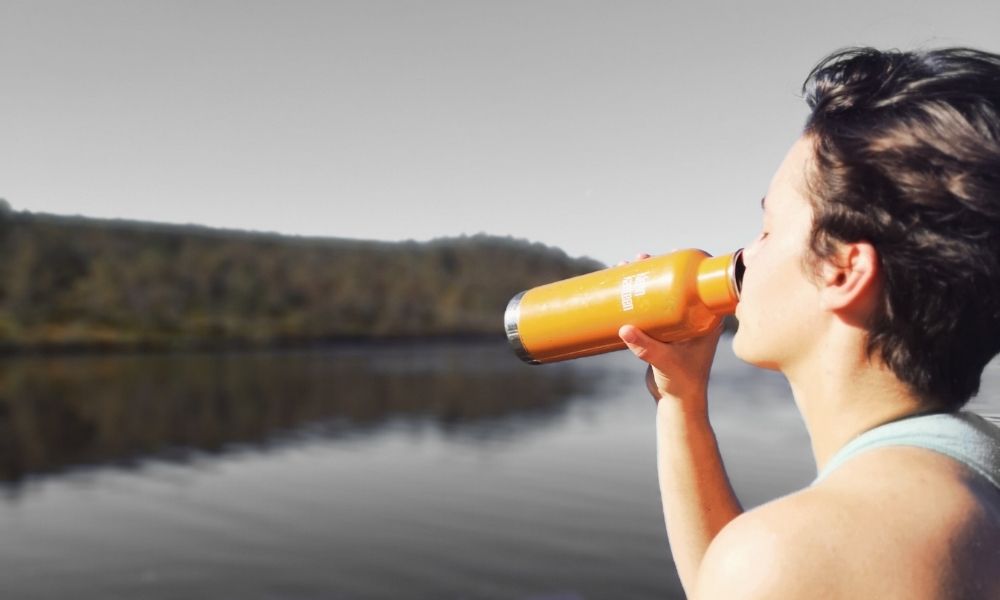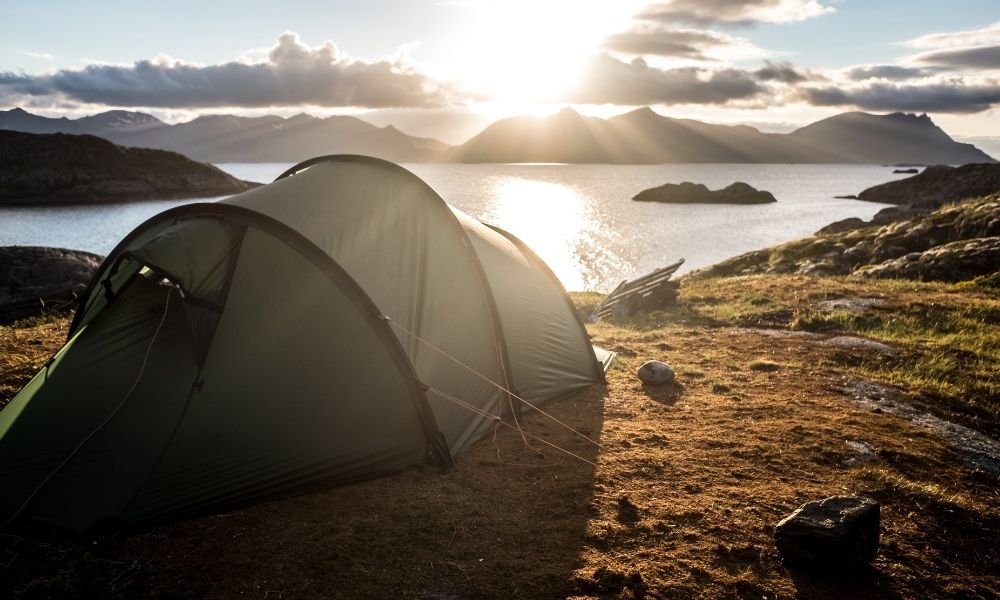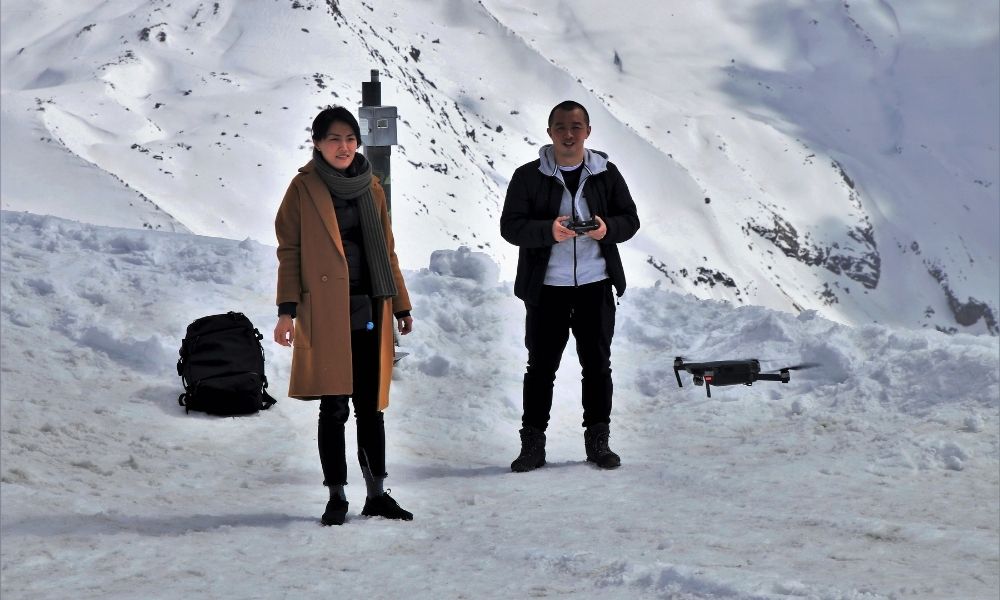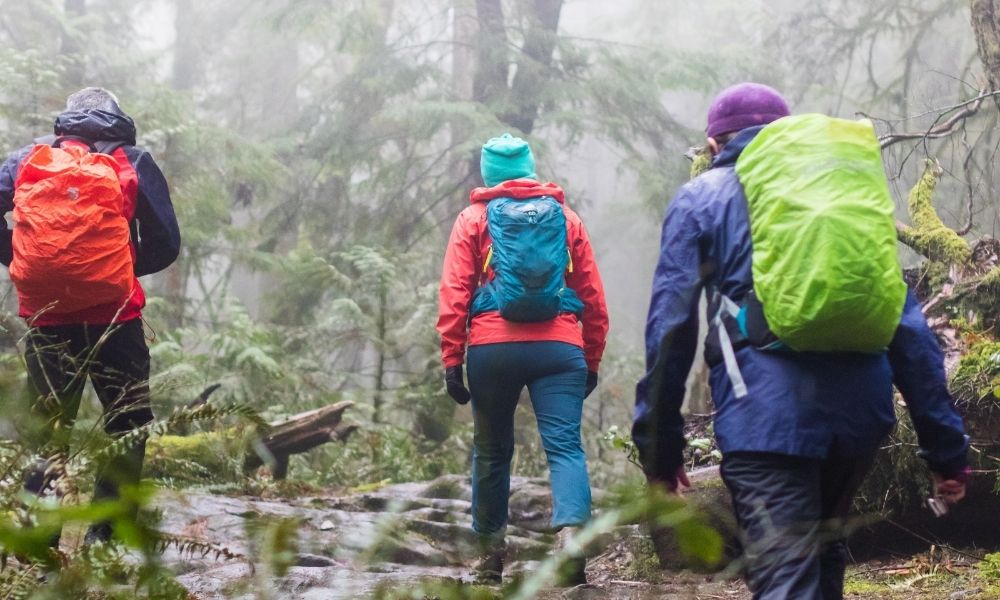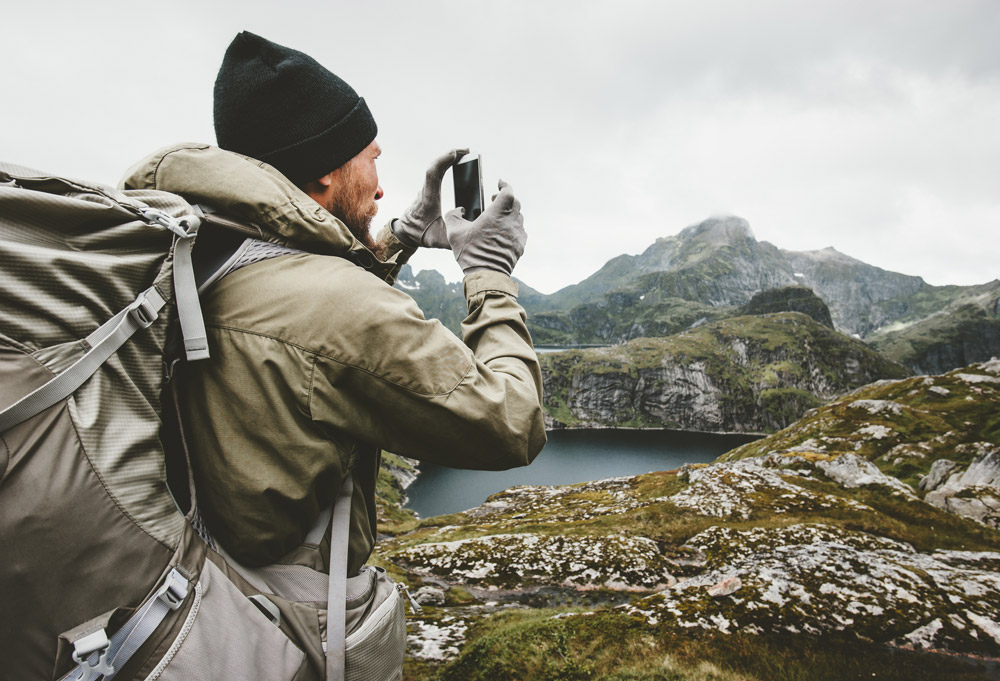Sure, you could just let experience be your teacher; but why not read up on some established tips for the perfect trip?
Prepare for the Outdoors with these Backpacking Hacks
There are a few tricks which can help beginners and experts alike have memorable and seamless trips. Master these useful backpacking tips below and stay safe, healthy, and energized as you conquer the wild.
1. Waterproof Your Backpack
The rain can infuse your backpacking trip with a sense of beauty and calm. Heavy rain, however, can expose the ill-prepared to considerable challenges. That’s why waterproofing your items when heading out to stormy weather is an essential backpacking hack. To keep the dampness at bay through your showery river valley hike, waterproof your backpack first and foremost. You do not want to get to camp and have to deal with the soggy gear. Waterproof bags can be expensive, but lining an ordinary backpack with a shopping/compactor bag or a backpack liner, will work just as well and cost a lot less. Second, keep all your heavy-use items outside the pack. Simply place them in dry bags, then store them in your pockets or external storage compartments. Opening your bag every few minutes in the rain will allow substantial moisture in. You will not only have wet items, but a heavier backpack as well. Finally, store your maps in a ziplock–or plan to bring a waterproof map that won’t get ruined in the rain. Similarly, safeguard your gadgets by storing them in watertight freezer bags.
2. Watch Out for Trail Hazards
Moisture in your gear is an annoyance, but a wet environment can be straight-up dangerous if you’re not taking care. Wet forest hiking trails are deceptively slippery, even for hiking boots with robust traction. Tread carefully over slimy logs, rocks, and muddy slopes. Moreover, if you encounter any sort of obstruction or object in your path, a good rule of thumb is to step around them, rather than on top of them. And when wading through streams, make sure to search out solid ground before taking your next step–a simple improvised walking stick can help here big time. Trekking poles are even better on rainy hikes. Always keep safety in mind to mitigate risk. Avoid daredevil actions that can cost your life out in the wild. Think ahead: for example if you’re going through a swollen creek, loosen your pack’s hip belt before getting in. If you are accidentally swept off, you can quickly free yourself of the backpack’s weight and swim to safety, away from the currents.
3. Source Information from Forecasts and Fellow Hikers
Real-time information from other backpackers will make your trip more enjoyable–and a lot safer, to boot. Your most invaluable resource is a hiker who’s familiar with the trail ahead–they can give you tips on where to camp, trail conditions, and info on available water sources. And more importantly, they can point you towards the region’s hidden gems as well! Weather forecasts will keep you clear from canyons that have the danger of flash flooding. Planning well ahead can make you aware of seasonal threats, allowing you to hike during relatively safe times of the year. If you see a ranger on the trail, don’t be afraid to pick their brain.
4. Build an Effective Layering System
A greenhorn could easily underestimate the vital role that clothing plays in the world of backpacking. In contrast, the veteran hiker knows how to balance the need for insulation with minimal bulk. Efficient layering is all that stands between you and the rain, snow, sun, and wind. As such, inadequate insulation and protection is a recipe for disaster when you are held up in remote locations. A hiker unsure of their clothing demands will tend to overpack. Their backpacks will be heavier than they should be, and the bulk will quickly reveal itself as a burden. Always put forethought into an efficient layering system–it will definitely pay off in the field. Have a base, mid and outer layer that you can comfortably wear all at once; but make sure they’re easy to take on and off in response to weather changes. Here’s how to pick the right gear:
What to Look for (and Avoid) in a Base Layer
You probably have listened to stories of woe from backpackers that went hiking in fall weather with only a t-shirt for their base layer and a thick jacket for their outer layer. If you have not crossed paths with such an unlucky soul, this is generally what they experience: The temperature rises, and they begin to sweat. Their heavy jacket turns into a swamp, but they can’t take it off because they’ll freeze in their t-shirt. Moreover, a sweaty tee will make you lose body heat even faster as the frosty, chilly air bites. Another common mistake is going off into the wild in a long-sleeved cotton base layer. As sweat forms, cotton’s superb absorption features will take all that moisture in, rather than wicking it away like a good base layer should. A puffy jacket cannot protect you from the sweaty cold that comes from within. Thus, your base layer should keep you warm and dry. It should also have a snug fit. You can choose between synthetic or wool base layers. Wool is warm and odor resistant, while synthetics have superior wicking qualities and are cheaper than wool. Merino wool is an efficient insulator, and fights off bacteria that make you stinky–we primarily recommend this material for cold weather. Synthetics like modal are better for warmer weather and lighter thermal duty during physically demanding trips.
Always Have a Good Mid-Layer Item
While base layers manage moisture from the body, mid layers trap heat, keeping you insulated and cozy. A smart backpacking hack is to bring along a good mid-layer, even if there is a low likelihood of cold. For example, a fleece sweater is lightweight, breathable, and warm. It will dry fast when wet, so it is an excellent mid-layer. You can also take along a mid-weight synthetic or down puffy jacket layer to keep your body heat trapped. The best mid-layers pack down well, and will not crowd your backpack. For bottoms, have a good pair of weather-resistant hiking pants that allow tights or long-johns underneath.
Bring Along a Sizeable Puffy Outer Layer
You will enjoy your tour of the backcountry more if, at the end of a long day, you have a comfy outer layer to retreat into and relax. If there is a cold-weather forecast, always go for a bigger jacket. In such conditions, having a toasty and puffy outer layer outweighs any benefit you might accrue from space or weight saving, as they vital serve a protective function. A good outer layer should shield you from the heavy downpours, wind gusts, or snowfall. Look for gear with a water-repellant finish, yet also sport a good level of breathability. Wind breakers and soft shells are outer layers which work for moderate weather day trips. They are not usually waterproof, so consider them more for niche usage than your go-to armor for conquering the back of beyond.
5. Avoid Hypothermia
Hypothermia can creep in announced when backpacking in rainy or cold weather. Some of its early symptoms are confusion and shivering, which shouldn’t be shrugged off. When you get a chance, be sure to change out of any wet clothing or gear–and always make sure you’ve got an extra set of dry clothing. Besides staving off frostbite, cozy, dry clothes will also give you comfort and re-energize you. If your socks and pants tend to get too wet along the way, take the opportunity at your next stop to either change, or prep a spare set of clothes for quick donning down the road. Make sure to repeat this process for the next day’s hike. During days of unrelenting rain, stop moving and dry your gear when the sun shines. Your utility cord will make an excellent clothesline. If need be, take a full day off to dry out wet items after a storm. Keep your wet gear outside the tent; you do not want one wet item ruining the comfort of your cozy sleeping bag or dry clothes. A wet item also adds staleness to the tent’s atmosphere.
6. Pick the Right Campsite
Camping will give you a generous opportunity to bond with other backpackers. It’s also the perfect time to be at ease with Mother Nature. But, it’s important to pick the right campsite, or else you’ll be too busy fighting off the elements to enjoy your stay. When roughing it out in the wild, always go for high, dry ground. This setup keeps your tents free of moisture from dew or saturated soil. The best place to pitch your tent is under trees. Vegetation will create a warm bubble around you, and you will have less condensation to deal with inside your tent. That said, avoid camping under trees that have old or damaged limbs. A gust of wind could have a thick branch crashing down on your tent. An excellent campsite is near a source of water. Always check for any prohibitions and regulations that affect camping near rivers or streams. And in rainy seasons, don’t set up camp in valleys flanking high areas; you could easily have your tent swept away by a water channel. When pitching a tent, ensure your doorway does not face the wind. Lastly, do not pass up a scenic campsite just to keep up with your travel schedule. Be flexible and savor every magical spot you find, as that is what memories are made of.
7. Hygiene Hacks
For many backpackers, personal hygiene is a social contract reserved for the civilized world. They say: “Out in the wild, embrace some grime.” They do have a point. You cannot possibly lug around enough spare clothing to change into daily without adding substantial weight to your luggage. This means that you will have to wear some of your gear for a trip’s entirety. You will be a tad stinky before your trip is up and you’re back home enjoying that hard-earned shower. That said, you can pack multiples of underwear and socks. You will need to wash and air these items so that you can cycle them during your trip. If your moisture-wicking base layer is synthetic, it will hold a level of odor. While you will quickly get used to the stink, your tent partner might not like it much. So scrub off the dirt when you have access to fresh water. Some backpacking hacks for hygiene include having hand sanitizer as part of your essentials. Keep an unscented 1 oz bottle on your hip belt to ward off bacteria when eating. Soap is fine for outdoor bathing and washing so long as it is biodegradable, though always try to keep it away from natural water sources. Have a travel toothpaste and folding toothbrush for warding off swamp mouth. And for your pits: clean wipes, a bandana, or a light washcloth will suffice when you have limited access to water. Avoid deodorants, as they might attract bugs and other creatures.
8. Stay Hydrated
Backpacking is a superb way to stay fit, happy, and healthy. Lots of exercise, sunshine, good vibes, and fresh air. That said, it is an exacting venture, which can cause rapid dehydration. When setting out for the day, have a cup or two of clean water. During the hike, stay proactive. You are already well on your way to dehydration when your body sends off thirst signals. Use a bladder to keep your water easily accessible without fumbling for it; after all, you’ll need to drink it regularly. Avoid alcohol and have sufficient water and snacks for energy.
9. Improvise Heating for Your Tent and Sleeping Bag
During wintry nights, heat some water and pour it into your Nalgene. Place a shirt or bandana around it and place the bottle under your sleeping bag. The water’s heat will quickly spread through your tent, keeping you cozy. Place your innerwear near the bottle to keep them warm enough for skin contact in the morning.
10. Bring a Change of Shoes
While a good pair of hiking boots will handle all the rigors of backpacking, you will need a change of shoes when at camp. Bring along a pair of lightweight sandals to stroll around the camp in. They will be particularly vital at night when you need to run out and empty your bladder.
11. Have Clean Clothes for the Trip Back
When you are finally back in your car after days or hours in the wilderness, you will love the feeling of comfy shoes on your feet. Pack a clean set of clothing as well for extra freshness after days of grimy gear. If you can’t afford to reserve space just for clean clothes you’ll only wear back to civilization, make some plan to wash or refresh your clothing along the way. Keep a unit of biodegradable detergent or soap on you so that you can wash your soiled gear. We also recommend you keep some spare rope or cable in your pack to use as an improvised clothing line to help them dry. Again, picking fabrics like merino wool and synthetics make this much more practical, as they dry out a lot faster than cotton and don’t pick up bacteria as quickly–so less vigorous washing is necessary.
Conclusion
For the ultimate backpacking success, have a good balance of hiking skills, clothing, shelter, diet, and rest. But above all, plan ahead with these backpacking hacks to have a worry-free trip out to the wild. Are there any backpacking hacks you’ve used other than what we’ve mentioned? Feel free to share with us in the comments section.
